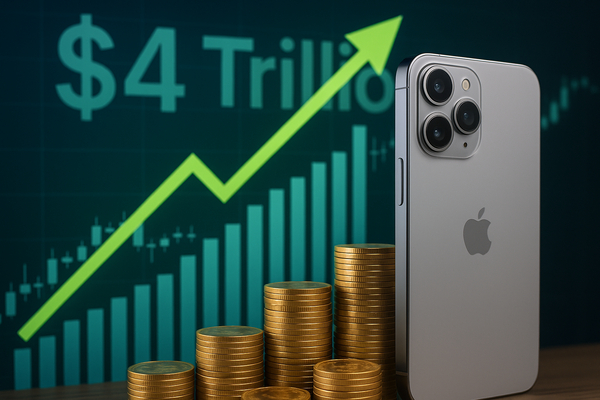
Apple surges to $4 trillion on iPhone 17 momentum. The stock jump reflects strong early iPhone 17 demand in the U.S. and China, a tech-sector rally driven by AI interest, and a string of supplier moves that are re-shaping component supply. In the short term, higher device sales and market sentiment have pushed indexes to fresh highs. Over the long term, product refresh cycles, services growth and supply‑chain consolidation matter for margins and capacity. Globally, the move lifts U.S. and European tech benchmarks and tests supply lines in Asia and emerging markets. The timing is urgent because Apple reports results this week and several major supplier deals closed this session.
What pushed Apple to $4 trillion and why it matters now
Apple (NASDAQ:AAPL) reached a $4 trillion market value after a market rally that coincided with strong early sales of the iPhone 17 in the U.S. and China. The surge also tracked broader appetite for AI beneficiaries and record-setting sessions for peers such as Microsoft (NASDAQ:MSFT) and Nvidia (NASDAQ:NVDA), which have each crossed multi‑trillion dollar thresholds this year.
Short-term, the milestone lifts stock-market sentiment and concentrates focus on Apple’s upcoming quarterly report scheduled for Thursday. Longer-term, it signals resilience in Apple’s product cycle, the stickiness of services revenue and potential upside from new form factors and OLED upgrades slated across the Mac and iPad lines.
Market context matters. Big Tech earnings this week — including Microsoft and Amazon (NASDAQ:AMZN) — put Apple’s results in a running narrative about where consumer device demand meets enterprise AI spending. Analysts such as Wedbush have reiterated bullish views; Wedbush kept an Outperform on Apple with a $310 price target ahead of earnings.
Supply chain and supplier M&A: immediate pressure and consolidation
Apple’s milestone came on the same day that two of its mobile RF suppliers agreed to merge. Skyworks Solutions (NASDAQ:SWKS) and Qorvo (NASDAQ:QRVO) announced a cash‑and‑stock deal creating a combined company valued at about $22 billion. Under the terms, Qorvo shareholders receive $32.50 in cash plus 0.96 Skyworks common shares per Qorvo share. The companies say the combination will target approximately $7.7 billion in combined revenue and roughly $2.1 billion of adjusted EBITDA.
The deal tightens the pool of radio‑frequency and mixed‑signal suppliers that serve Apple’s iPhone and other handset customers. Skyworks also reported preliminary fiscal Q4 revenue of $1.10 billion in the filing that accompanied the merger announcement.
At the same time, supplier weakness surfaced. Corning Incorporated (NYSE:GLW) reported optical communications net sales of $1.65 billion for the quarter, below analyst estimates of $1.73 billion. Corning’s optical fiber business has been pressured by slowing network investment in China and a new anti‑dumping tariff of 37.9% on certain fiber imports. Corning shares fell more than 7% in premarket trading on the report even though the stock has climbed roughly 85% year‑to‑date.
These moves have two immediate implications. First, consolidation such as Skyworks‑Qorvo can deliver R&D scale and product breadth that suppliers need to match rising RF complexity in modern handsets. Second, regional trade actions and tariffs — exemplified by the 37.9% Chinese anti‑dumping tariff — highlight geopolitical and policy risks that can compress supplier revenue and shift sourcing decisions.
Earnings, product roadmap and the near-term watch list
Apple reports quarterly results this week, and investors will be watching iPhone unit trends, service revenue, and gross margin detail. The earnings cadence matters because it will clarify whether the iPhone 17’s early strength is broad or concentrated by geography or carrier promos.
On product roadmaps, Apple is testing multiple hardware upgrades. Reports say Apple plans a 2027 iPad Pro with the M6 chip and vapor‑chamber cooling. The company is also testing OLED displays for MacBook Air, iPad Air and iPad mini — with the iPad mini expected to be the first to use OLED as soon as next year. Analysts are also flagging a possible foldable iPhone development as a multi‑year upside driver for the handset line.
Broader market forces will shape how investors parse Apple’s results. The Federal Reserve’s near‑term policy path and the Big Tech earnings wave — which includes Microsoft and Amazon reports this week — will influence multiple valuation multiples across the sector. Separately, supply‑side consolidation, new tariffs and chipmaker tie‑ups raise short‑term volatility around supplier stocks and component availability.
Key takeaways:
- Apple reached a $4 trillion market cap on strong early iPhone 17 sales and a broader AI‑led market rally.
- Skyworks (NASDAQ:SWKS) and Qorvo (NASDAQ:QRVO) agreed to merge, creating a ~$22 billion RF and mixed‑signal supplier with $7.7 billion revenue scale and ~$2.1 billion adjusted EBITDA.
- Corning (NYSE:GLW) reported optical communications sales of $1.65 billion vs. $1.73 billion expected and faces a 37.9% anti‑dumping tariff in China on some fiber imports.
The next 48 hours will be instructive. Apple’s earnings release and suppliers’ guidance will offer the freshest data points on demand, margins and how component consolidation is unfolding. Watch product commentary, regional sales detail and supplier guidance for the clearest signals.
Note: This article is informational. It summarizes recent market and corporate developments without offering investment advice.












